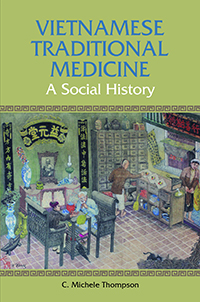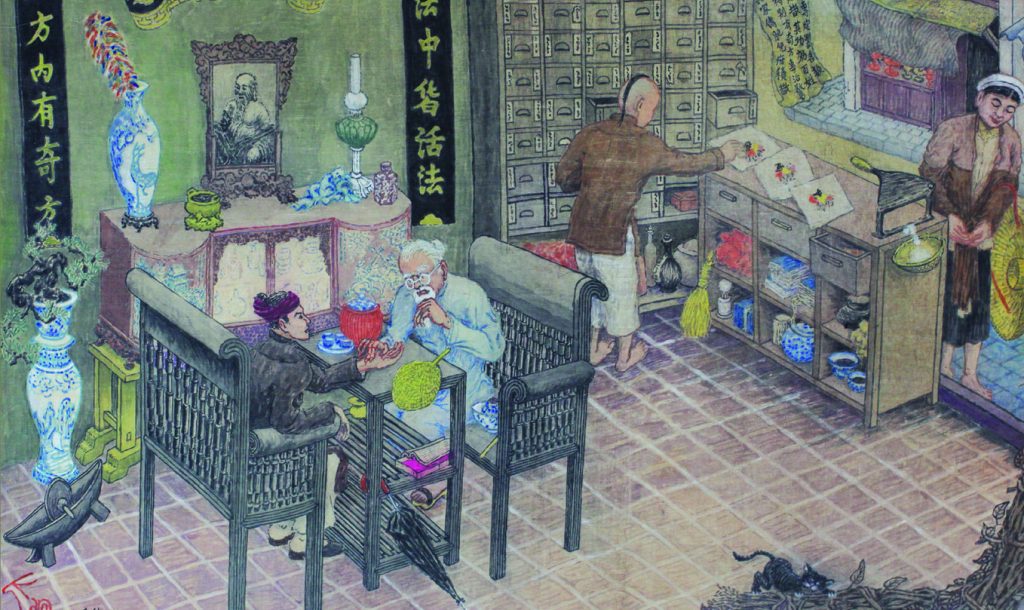 C Michele Thompson, Vietnamese Traditional Medicine: A Social History, (Singapore: NUS press, 2015)
C Michele Thompson, Vietnamese Traditional Medicine: A Social History, (Singapore: NUS press, 2015)
Reviewed by Wynn Gadkar-Wilcox
In recent years, scholars of Vietnamese history have given us many accounts of 20th century political and cultural history.
However, English-language studies of the history of medicine in Vietnam are comparatively rare, as are social histories of Vietnam prior to the 20th century. Even as our knowledge of Vietnam’s political history expands exponentially, pre-20th century Vietnamese social history, including the history of medicine, has not developed at the same rate.
Fortunately, a new series on the history of medicine in Southeast Asia being published by NUS press in Singapore is shining light on this subfield. C Michele Thompson has given us an excellent contribution to this series with her new book.
The book’s subtitle, A Social History, is quite appropriate. Thompson deftly weaves together ideas drawn from her knowledge of linguistics, biology, and history to explain Vietnamese medicine in the context of Vietnamese society. The book is filled with interesting linguistic analyses in which Thompson parses key words in Chinese andchữ nôm (demotic Vietnamese characters). In addition to her expertise on language, Thompson draws heavily on her knowledge of both Chinese and Southeast Asian history, her understanding of immunology and biology, and her appreciation for trends in literature throughout this valuable and unique volume.
The practice of Vietnamese medicine exists at the intersection of many cultures and societies. While it borrows heavily from Chinese medicine, the Vietnamese, as Thompson points out, rely much more heavily on pharmacopeia and plant-based remedies than their neighbours to the north. Medical practice is also subject to rich regional variation within Vietnam. Moreover, since the early nineteenth century, it has been heavily influenced by developments in Western medicine. Thompson puts smallpox at the center of her narrative, using it as a case study to investigate the interactions of Chinese, Vietnamese and Western medicines. This approach helps sustain the intrigue of her narrative as Thompson unfolds layers of development and complexity stemming from the interstices of these very different practices.
Thompson narrates her book almost as a detective story, and uses her interdisciplinary expertise to uncover clues on the path to solving the historical mysteries of traditional medicine in Vietnam. In Chapter 1, for example, she asks why the Vietnamese royal court would have accepted a smallpox vaccination procedure that involved cutting the body, in violation of commonly-held cultural precepts in Asian medicine.
She investigates how Dr Jean-Marie Despiau, a Nguyễn royal medical physician who was French, managed not only to acquire vaccinia from Macao and successfully transport it to Vietnam, but also convince the royal court to accept vaccination in the early 1820s. She asks why, if Dr Despiau had been so successful in that effort, he was remembered as a mediocre physician. To answer these questions, she delves deeply into available sources of the period to demonstrate that Despiau was on the wrong side of the expatriate community in Vietnam at the time.
Her encyclopedic knowledge of the subtleties of smallpox remedies in Europe in Vietnam and in China makes this chapter very satisfying. Similarly, in Chapter 2, Thompson very effectively explicates the subtle differences in regional remedies across Vietnam, as well as differences between Chinese and Vietnamese Medicine, by analysing subtle differences between variant characters in Chinese and in chữ nôm.
Finally, Thompson’s talent at crafting her narrative as detective work is evident in Chapter 3, in which she contemplates why traditional Vietnamese medicinal practitioners continued to use nôm in certain circumstances even into the 1990s — even though most scholars of Vietnamese languages insisted that nôm become virtually obsolete by the 1920s. This surprising finding allows Thompson to use linguistic change as a device to understand the interactions between Western, Chinese, and Vietnamese medicine in the 20th century.
Some readers attracted to this book by its title might be disappointed that it does not attempt to give a comprehensive history of Vietnamese traditional medicine. In fact, the book generalises only carefully from the case study of smallpox out to larger issues in Vietnamese medicine, and presents cursory information prior to the 19th century. The specificity of the book’s contents is among its strengths; however, it remains possible that readers will be misled by the title.
Additionally, some readers may be confused by the fact that even though the book focuses on smallpox until the end of Chapter Two, Chapter Three hardly mentions smallpox. In that chapter, Thompson pays far closer attention to questions of language acquisition and Westernisation than smallpox specifically. To her credit, however, Thompson makes very clear the connections between each of the chapters in the introduction and the conclusion of her volume.
Readers may be somewhat confused by the book’s inconsistent editing choices. While the majority of Chinese names are rendered in Pinyin, occasionally toponyms and other key terms will be rendered without explanation into Wade-Giles. In Chapter 3, Thompson engages in a discussion of several nôm characters that are not displayed in the text. It would have been desirable for NUS press to find some way to offer readers legible versions of these characters, even if it were only in pictorial form, as that would have clarified her discussions of them.
Finally, the statement that “there seems to have been little if any of the corresponding denigration of traditional medicine similar to the attacks on Chinese traditional medicine which occurred in China,” may be too strong. While it is probably accurate to say that hostility to traditional practices never reached the fervour of the Chinese new culture movement, the various writings of Vũ Trọng Phụng, such as Dumb Luck andLục Xì, show that at least some Vietnamese thinkers could be quite critical of traditional medicine.
None of these minor concerns about editing should obscure the fact that Thompson’s study should now be recognised as a foundational work in the history of Vietnamese medicine. There is no other available study in English that presents such an accessible introduction to the subject of Vietnamese medicine in the 19th and 20th centuries as Thompson’s. It should become the standard work in this field for many years to come.
Wynn Gadkar-Wilcox is Professor and Chair at the Department of History and Non-
 Facebook
Facebook  Twitter
Twitter  Soundcloud
Soundcloud  Youtube
Youtube  Rss
Rss 